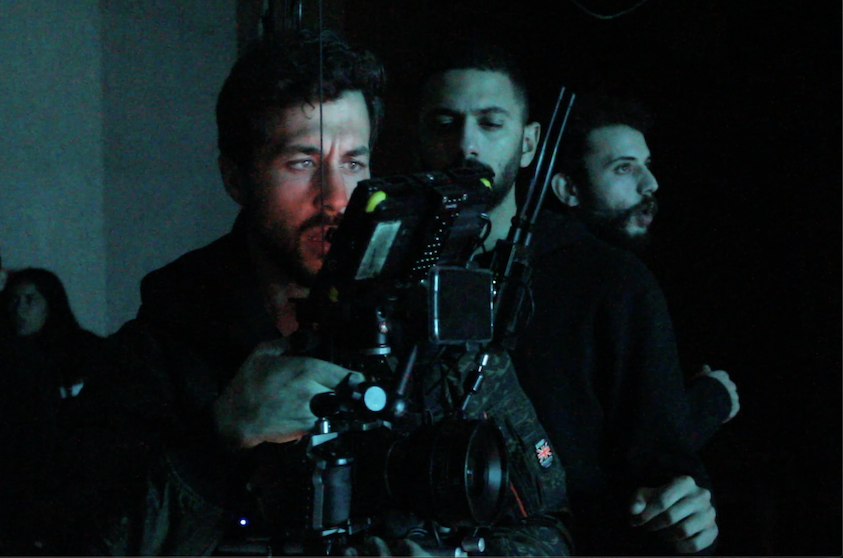The nine-to-five lifestyle has been slowly diminishing in the last several years worldwide, with “hustle” culture finding its way to the forefront and books like “The Four Hour Workweek” trending. Many college graduates find themselves trying to escape corporate culture and an office job, fleeing to a “freelance life” that offers them attractive work hours and personal freedom.
Egyptian Streets spoke to several current freelancers in all different fields for this series about freelancing to gather an understanding of the current Egyptian freelance market.
The pay rates in each market differ greatly, and it is easy to be manipulated as a beginner or to be treated like an intern, or even be offered pay “in exposure”; a concept offering freelancers no pay and rather compensation in the exposure their work will get. These freelancers share their insight in the first article in the series focusing on videography and filmmaking.
Nada Mawsouf is a freelance director, filmmaker and film producer, and has previously worked on projects including the Cairo International Film Festival.
Mawsouf is not one to immediately praise the “freelance life”. She immediately acknowledges its difficulties and instability. However, with that, comes its benefits.
How did she get started, then?
“Talk. Talk to people about what you do and what you want to do. You would be surprised when someone recommends you to take a job. I got my first job in the field because a friend knew what I was interested in and sent my CV to their friend,” Mawsouf tells Egyptian Streets.
What is all this talking about? What should you say?
“Introduce yourself. You need to know what to say and how to say it. Think of yourself as an idea. You need to sell that idea to someone in 30 seconds, what are you going to say?” she asks.
Talking and introducing oneself sound like basic everyday activities, what if you actively want a job now?
Mawsouf recommends writing a list of people you want to work with and starting to approach them.
“We can all thank social media for it has made this very easy. I have gotten to know people in the field through social media, gotten to attend festivals and get to know people.”
Once you’re in contact, whether or not you work with the person, stay in touch.
“This is something everyone told me to do. It’s not rude to call people and ask if they’re working on a project and if you can help out. However, don’t be a push-over. Ask nicely and not too often,” Mawsouf adds.
What if you’re not finding the gig just yet?
“Create. If you’re into the creative side of the field, then don’t wait for a job to be able to show people your work. Make 1-minute videos and post them online. Do fun edits. There are multiple ways to showcase your skills from the comfort of your home.”
This will help you with the next step: Showcase. Once you have some work done, put it together in one place and have an online portfolio ready. You should also have a CV, “but portfolios are the way to go in this field,” says Mawsouf.
What if you’re still not finding the gig?
“Keep trying. It’s not easy. I say that now and I’m still trying to get jobs in the field. It takes time, so don’t quit,” she adds.
And while you wait?
“Keep learning. Take workshops, ask for unpaid training and ask people how they did it themselves,” Mawsouf says.
View this post on Instagram
What if you’re still a high school or university student or even have a full-time job, but you want to be a freelance videographer?
Youssef Ramzy is here to help. Ramzy has been a freelance videographer for over five years now along with his university work, and has accrued experience in the Egyptian freelance creative market. He’s done both large and small shoots, and his latest work includes music videos for the Egyptian rap scenes’ up-and-coming artists.
“It all depends on your willingness and how much time you’re willing to allocate to freelancing. With time, the work will come, because this industry is all based on word of mouth. If your name and work and reputation are good, you’ll get work. The more work you get, the more you can leverage and increase your pay,” Ramzy says.
As Mawsouf says, your portfolio is essential, and it is what will find you work. Ramzy advises that you have work of all kinds in your portfolio. The keyword is diversify: with food videos, schools, weddings, sports events, restaurants, startups, etc, till you find your niche.
“If you already have a niche and you feel that you’re good in one specific industry like food, stay within that and be the best food videographer out there. If you still don’t know your niche, try literally everything, even if the rates aren’t high, so you have something to show the next client,” he explains.
Now, what if you’ve found your first gig?
Congratulations!
“Number one rule: never take a job for free. You have to value yourself even if it’s 200 or 300 EGP, in the case that you want to build your portfolio, and you want to work on any job. Never compromise your salary or your wages, even if it’s a really small amount of money. Any incentive is good, just so that the client can feel that you’re of value,” Ramzy tells Egyptian Streets.
For newbies working on their first jobs, Ramzy recommends asking for a 1500 EGP rate for a small shoot.
“You can climb the ladder bit by bit, after four or five gigs, you can level up to 2000-2500 EGP. The more you work, the more people will need you and the more you can level up your fees. It’s the power of no, once you’re able to say no to a job, that’s when you know you’re of value and you know your self worth as a freelancer,” he adds.
How do I measure my rates? By day? Hour? Minutes of Video?
Some people like to measure it per hour, Ramzy says, and some like to measure per project, or per day. He likes to combine all of these measures for the most efficient and fair method.
“For example, if I have a client that tells me they want to film a video for 1000 EGP per day, for example. I divide my day by working hours, so for a full day (12 hour day), I’ll take 1000 EGP. For a half day, which is five to six hours, I’ll take 500 EGP. That way I did a mix of both, I didn’t tell them my hourly rate, but I gave them a day rate, whether a half or full day,” Ramzy explains.
When it comes to editing, some charge per minute of footage, but Ramzy doesn’t feel that’s an accurate measure and advises charging per minute of editing, “I count it per minute of the video, but with brackets, so X EGP per minute, up to three minutes, Y EGP per minute from three to five minutes, etc.”
For long-term projects, like a two-day, three-day, or a week-long shoot, Ramzy suggests providing a weekly quotation. “You tell them that in total this will cost 10,000 EGP, for example. If you want to know any details, I can give you the details.”
Ramzy used to charge clients for a whole project, from the idea to the shooting and editing. Now, he cuts it up, finding himself overworked and undercharged with the initial method. He advises any one-man-group to divide their work and divide the costs for each portion of a project for more accurate rates.
View this post on Instagram
“You have to make deals, the number one rule is compromise without compromising on your self worth. If your daily rate is 1000 EGP, and they want you for three days, and that gives a total of 3000 EGP – no. Discount it, and make it 2,200-2,300 EGP for example, since you’re working with them for three days and you’re guaranteed three days of work,” Ramzy adds.
I think I’m at the point where I can turn down jobs that don’t suit me. Should I?
Never directly turn down a client, Ramzy says. “Never tell them no because of their budget, bargain with them and tell them I can offer so and so and I can compromise on so and so, and be fair,” he says.
Even if you don’t reach an agreement regarding rates or otherwise, Ramzy advises keeping the conversation as graceful as possible, by saying “I hope we can work on something else together and I just wouldn’t feel satisfied going below this specific rate.”
The client will respect that, he says, and you may work on something else together in the future.
“You never want to lose a client because when you do, you can cut the string of clients, it’s the butterfly effect. Even when you turn down a client, do it with a lot of grace, after you try to compromise. Even when you get really big, don’t turn down the client – give them a solution. Ask how you can help them, or find them someone else who will take less money. The client will definitely appreciate it,” he says.
I’m busy with my job, is this sustainable? How do you do it all?
The sustainability of freelancing depends on each person and their lifestyle. Nada Mawsouf recommends certain strategies to make sure your time is managed.
“Prioritize your projects and don’t take too many jobs at the same time. And if you work on a big project, make sure you take a break after. If there is a time when you’re not working on a project, think of what other projects you can try and get. This in itself is part of freelancing,” she says.
For people in high school, university, or working, Ramzy recommends a 70/30 ratio.
“Allocate 70 percent of your time, if you want freelancing to be your part time gig, on what you’ve got to do, and dedicate 30 percent of your time to freelancing. If you’re working or studying, focus on freelancing on the weekend,” he adds.
Is freelancing full time possible?
“It is possible. Nothing is impossible. I know it sounds cliche. It’s not the safest option. But I’d definitely advise you to take it step by step. Never go full-time if you don’t have a clear vision of what you want to do,” he says.
For those in school and university, he advises to start building until you have several opportunities and it’s working well. One can work 10 days during a given month, and not find work for the entire following month, but 10 days of freelancing can make up for an entire month of a regular salary at the average company, he adds.
“I’m still concerned about freelancing, it’s month-to-month. I calculate total profits of the year divided by 12 months, so I could see how it compares to a regular day job. It’s good, but is it sustainable? I’m not really sure yet. It definitely will be when your name is well-known, because in this industry there’s lots of room to thrive,” he says.
The big names work three or four times a month, but the four times cover the whole month, and that’s the point, Ramzy says. That is why most people get into freelancing, because eventually it provides the best of both worlds: a good salary, and flexibility with free time.
However, like any form of success, getting there will take time and hard work.
“$1,000,000 in the bank isn’t the fantasy. The fantasy is the lifestyle of complete freedom it supposedly allows,” said Timothy Ferriss in his book The 4-Hour Workweek.
This article is the first in a series Egyptian Streets is producing about freelancing in Egypt. Stay tuned for future articles on freelancing in the fields of the visual and graphic arts as well as writing and reporting.







Comments (22)
[…] Navigating the Freelance Life in Egypt: Video and Filmmaking A Story About Vulnerability: Egyptian Singer Malak Exposes the Raw and Authentic in Music […]
[…] Navigating the Freelance Life in Egypt: Video and Filmmaking Egypt’s Dar Al-Iftaa Launches ‘Birth Control is Permissible’ Hashtag to Counter Overpopulation […]